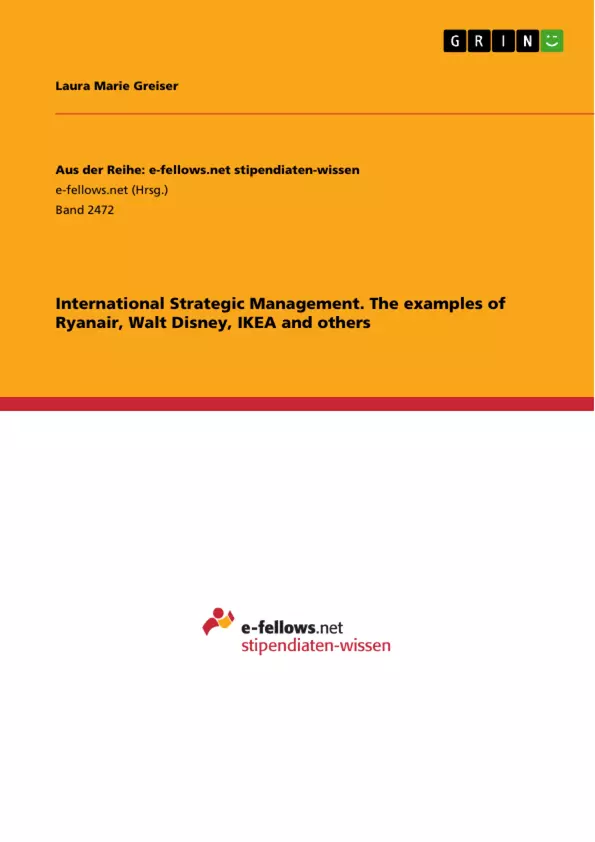Elaboration of Harvard Business Cases: Ryanair, Walt Disney Company and Pixar Inc., TAV, Aldi, Diageo, The Weather Company, IKEA
Inhaltsverzeichnis (Table of Contents)
- Dogfight over Europe: Ryanair (A)
- Should Ryanair launch its strategy? Yes or No
- What will be Ryanair's probability at I£ 98 in Irish pounds?
- The Walt Disney Company and Pixar Inc.: To Acquire or Not to Acquire?
- Should Disney pursue the Pixar acquisition and should Pixar allow itself to be acquired?
- What alternative strategies could Pixar and Disney pursue to generate similar value?
- If Disney does acquire Pixar, what organizational challenges do you foresee for the combined entity, and how would you meet them?
- TAV Airports Holding (A)
- How does TAV Airport Holding compare to other airport operators and what might be the reasoning behind the positioning?
- What could be a method/ process to come up with the last bid price offered during an auction?
- What should TAV Airports Holding do going forward?
- Aldi: The Dark Horse Discounter
- What are Aldi's competitive advantages? How did Aldi create its competitive advantages? What would you suggest Aldi should do to sustain its competitive advantages?
- How does Aldi's design for their business, not only externally, but operationally as well, fit with their competitive advantage (problem solved, opportunity created.)?
- Should Wal-Mart be worried about Aldi? Should Aldi be worried about Wal-Mart? Do you believe Aldi to be at a competitive advantage of disadvantage relative to Wal-Mart?
- What aspects should Aldi consider before deciding on whether to include a single new item/ product in their supermarkets?
- Aldi's current way of doing business slightly differs from the one described in the case. What differences to you see? What could be the reasoning behind the change?
- How has Aldi modified their business to different countries, why have they needed to do this?
- Diageo: Innovating for Africa
- What has been the biggest driver of Diageo's global growth strategy since 2002? Is this global strategy likely to change over the next 5 to 10 years?
- How would you evaluate Diageo's investments in Africa?
- How should Diageo respond to increasingly direct competition in the African market for alcoholic beverages?
- What further advice would you offer to Nick Blazquez?
- IThe Weather Company
- What are the core assets of The Weather Company (TWC) when David Kenny joins in 2012?
- What are the challenges facing The Weather Company?
- What are the core assets of The Weather Company after almost two years of David Kenny's leadership in early 2014?
- What skills did Kenny use to implement his vision? How would you assess his leadership skills?
- What are the results as of January 2014? Are the changes complete and sustainable or not? Going forward what should Kenny be most concerned about and what should he emphasize now?
- What can other companies learn from The Weather Channel case regarding the dealing with "big data"?
- IKEA
- How would you assess IKEA Group's People and Planet Positive sustainability plan? Is the plan likely to help the company transform its business? Are the plan's targets too limited, appropriate, or too ambitious?
- How do you feel about the progress IKEA Group has made implementing this plan?
- How does IKEA's sustainability strategy align with its business model?
- Which option(s) should IKEA Group pursue to address IKEA's Wood Supply Chain sustainability? Which has the highest leverage for IKEA?
- IIDogfight over Europe: Ryanair (A)
- Should Ryanair launch its strategy? Yes or No
- What will be Ryanair's probability at I£ 98 in Irish pounds?
Zielsetzung und Themenschwerpunkte (Objectives and Key Themes)
This collection of Harvard Business Cases aims to provide in-depth analysis of various companies and their strategic decisions. The cases examine a wide range of topics, including cost-competitiveness, market positioning, mergers and acquisitions, sustainability strategies, and global expansion.
- Competitive Advantage and Cost Leadership
- Market Analysis and Strategic Positioning
- Mergers and Acquisitions: Benefits and Challenges
- Sustainability Strategies and Corporate Social Responsibility
- Global Expansion and Adaptation
Zusammenfassung der Kapitel (Chapter Summaries)
The "Dogfight over Europe: Ryanair (A)" case focuses on Ryanair's low-cost strategy and its viability in the European airline industry. The analysis delves into the competitive landscape and the potential impact of Ryanair's unique pricing model. The "The Walt Disney Company and Pixar Inc.: To Acquire or Not to Acquire?" case explores the potential benefits and challenges of Disney acquiring Pixar, including the strategic implications for both companies. The "TAV Airports Holding (A)" case analyzes TAV's positioning in the airport management sector and its strategic approach to auctions and future growth.
The "Aldi: The Dark Horse Discounter" case investigates Aldi's competitive advantages in the grocery retail market, examining its unique operational model and its potential impact on competitors like Wal-Mart. The "Diageo: Innovating for Africa" case analyzes Diageo's global growth strategy and its investments in the African market, considering the challenges and opportunities of expanding into a new market.
The "IThe Weather Company" case examines the transformation of The Weather Channel under David Kenny's leadership, exploring its evolution from a traditional media company to a data-driven organization. The "IKEA" case explores IKEA Group's sustainability plan, analyzing its goals, implementation, and alignment with the company's business model.
Schlüsselwörter (Keywords)
The key terms and concepts explored in these cases include cost leadership, differentiation strategy, Porter's Five Forces, mergers and acquisitions, strategic alliances, competitive advantage, sustainability, global expansion, and market analysis. Each case delves into specific industry sectors, including aviation, entertainment, airport management, retail, alcoholic beverages, and data analytics.
- Citation du texte
- Laura Marie Greiser (Auteur), 2016, International Strategic Management. The examples of Ryanair, Walt Disney, IKEA and others, Munich, GRIN Verlag, https://www.grin.com/document/372307



